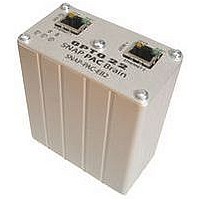SNAP-PAC-EB2 OPTO 22, SNAP-PAC-EB2 Datasheet - Page 2

SNAP-PAC-EB2
Manufacturer Part Number
SNAP-PAC-EB2
Description
I/O Processor
Manufacturer
OPTO 22
Type
PC Basedr
Specifications of SNAP-PAC-EB2
Accessory Type
Communication Processor
Leaded Process Compatible
No
Peak Reflow Compatible (260 C)
No
Signal Input Type
Ethernet, RS-232
Battery Type
CR2032 Lithium
Brand/series
SNAP Series
Communication
RS-232/485
Current, Input
750 mA
Dimensions
3.3"L×1.83"W×3.7"H
Input Type
Analog/Digital/Serial
Memory
16 MB RAM
Mounting Type
Rack
Network Protocols
IEEE 802.3
Number Of Inputs
4
Output Type
Analog/Digital/Serial
Primary Type
Controller
Temperature, Operating
0 to 60 °C
Voltage, Supply
5-5.2 VDC
For Use With
SNAP PAC System
Lead Free Status / RoHS Status
Contains lead / RoHS non-compliant
PAGE
2
I/O Processing
Each SNAP PAC brain mounts on a SNAP PAC rack with up to 4, 8,
12, or 16 SNAP I/O modules.
SNAP PAC EB brains support all SNAP analog, digital, serial, and
special-purpose input and output modules. SNAP PAC SB brains
support all SNAP analog and digital modules.
These modules can all be mixed on the same mounting rack and
placed in any position on the rack, to accommodate the required
mix of signals at any location. Each SNAP I/O module provides from
1 to 32 I/O points, depending on the module.
For more information on mounting racks, see Opto 22 form #1684,
the SNAP PAC Racks Data Sheet. For more information on SNAP I/O
modules, visit our website at www.opto22.com.
Multiple Protocol Support on Ethernet
In addition to I/O processing, SNAP PAC Ethernet brains support
communication using multiple protocols running simultaneously
over Ethernet. These brains support EtherNet/IP
SNMP for network management, FTP for the brain’s built-in file
system, SMTP (email client), and Opto 22’s open memory-mapped
LEDs and Network Interfaces—Ethernet Brains
Rack
View from top
Switched Ethernet network
interfaces
Brains can be networked in a daisy-chain
configuration or in a standard star
configuration using either Ethernet
interface. Both interfaces use the same IP
address.
NOTE: When using a daisy-chain
configuration, be aware that if power to a
brain is lost, all brains beyond it on the
network will also lose communication.
Brain
SNAP I/O modules
™
, Modbus
®
/TCP,
LEDs
OptoMMP protocol. Communication with OPC 2.0-compliant
clients is available through OptoOPCServer (see
below).
Software
SNAP PAC brains are primarily designed for use with a SNAP PAC
programmable automation controller. The controller runs a
control program built with PAC Project
software suite comes in two forms, Basic and Professional.
•
•
In addition to using a SNAP PAC controller with PAC Project
software, you can communicate with SNAP PAC brains using the
open and documented OptoMMP protocol. A free OptoMMP
Communication Toolkit is available on our website,
www.opto22.com. This toolkit includes ActiveX components and
C++ classes, so you can use programming tools such as Visual
Basic or Visual C++ to communicate with the brains. See form
#1465, the OptoMMP Protocol Guide, for more information.
Ethernet brains can also communicate with Allen-Bradley
RSLogix
the EtherNet/IP for SNAP PAC Protocol Guide, on our website).
In addition, Ethernet brains communicate using Modbus/TCP; see
Opto 22 form #1678, the Modbus/TCP Protocol Guide, for more
information.
Unnamed
STAT
PAC Project Basic, which is included in the purchase of a
SNAP PAC controller, consists of control programming, human-
machine interface (HMI) creation, and configuration software.
PAC Project Professional is available for purchase and adds
OptoOPCServer
database communications, and additional features.
LED
LNK
ACT
MS
NS
®
systems using EtherNet/IP (see Opto 22 form #1770,
Link established with Ether-
net network
Activity on Ethernet network
Brain status
EtherNet/IP Module Status
EtherNet/IP Node Status
Reserved for future use
™
for OPC connectivity, OptoDataLink
Indicates
SNAP PAC Brains
™
software. The PAC Project
“Software,”
™
for









